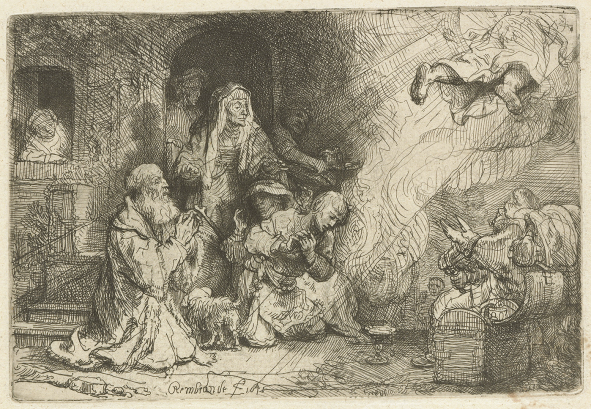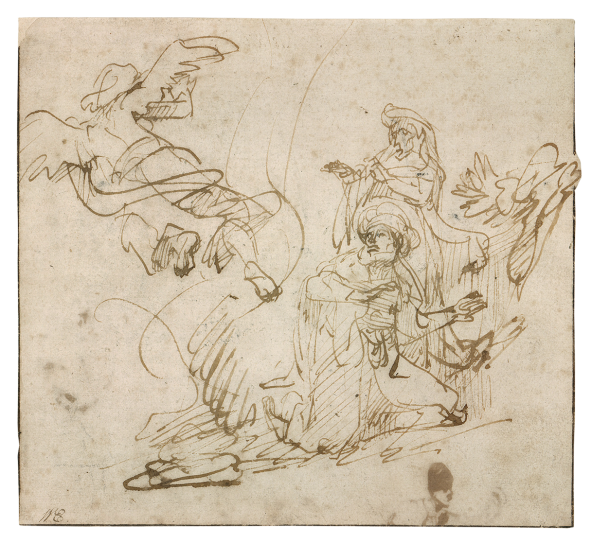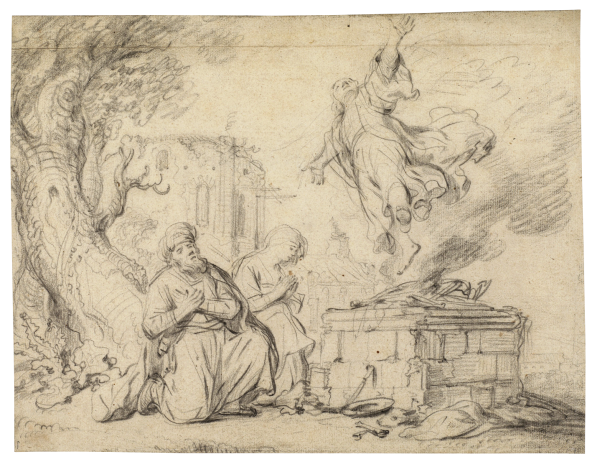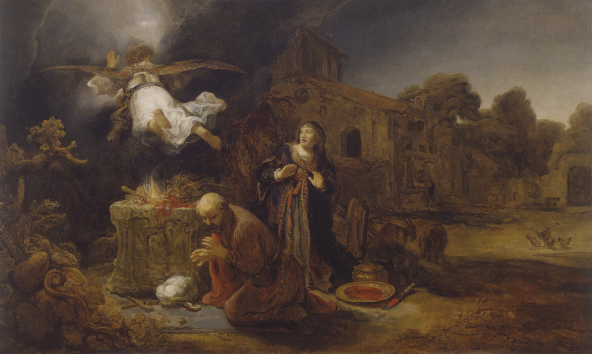Choose a background colour
Govert Flinck, Dutch, 1615-1660: The Sacrifice of Manoah, c. 1640-50
Pen and brown ink on paper
5 5⁄16 × 6 1⁄2 in. (13.5 × 16.5 cm)
- Chain Lines:
- Horizontal, 24 – 25 mm.
- Watermark:
- Foolscap with Five Bells, pendant with figure 4 and three circles
- Provenance:
Likely from a French collection, mid-nineteenth century (former mount made from calendar/almanac dated 1848 from A. Palyart & Fils Ainé); sale, Ader Picard Tajan, Drouot, Paris, 10 June 1988, lot 67; Sheldon and Leena Peck, Boston (Lugt 3847); gift to the Ackland Art Museum, inv. no. 2017.1.33.
- Literature/Exhibitions:
None.
- Ackland Catalogue:
- 2017.1.33
In the Old Testament book of Judges (13: 1-20), Manoah and his wife learn from an unidentified figure that they will conceive a child, the great hero Samson. Govert Flinck, who studied with Rembrandt in the 1630s, depicts the moment in the story when the messenger reveals himself as an angel, rising from the flames of their burnt offering. Manoah, with his head in his hands, his wife, and their two attendants look on with astonishment and reverence.
Flinck likely made this drawing shortly after his 1640 painting of the subject, now in the Bader Collection in Ontario, which was largely inspired by Rembrandt’s own drawing of several years earlier. Flinck subsequently used the Peck sheet as a basis for a more finished composition of the scene in black chalk (Courtauld Gallery, London), demonstrating his continued engagement with the story during the 1640s.
When this previously unpublished drawing by Govert Flinck entered the Ackland’s collection, the subject was thought to be the angel Raphael departing from the family of Tobias, a scene from the apocryphal Book of Tobit that was popular with Dutch artists at the time.1
Rembrandt (1606 – 1669) made an etching of the subject in 1641 that indeed bears a certain amount of compositional similarity with the present work Fig. 19.1.2

Rembrandt, The Angel Departing from the Family of Tobias, 1641. Etching on paper, 104 × 153 mm. Amsterdam, Rijksmuseum, inv. no. rp-p-ob-83.
Rijksmuseum, Amsterdam
Depicted here, however, is the Sacrifice of Manoah from Judges 13:1 – 20. The story relates how an angel likewise suddenly revealed his divine aspect and ascends to the heavens while spectators react in various states of awe. The unnamed angel prophesied the birth of the great hero Samson by telling Manoah’s childless wife that she would bear a son who would deliver the Israelites from the occupying Philistines. Manoah made a burnt offering in celebration of the news, at which point the angel revealed his true nature by rising with the flames from the offering. The smoking altar in the present work makes its true subject clear, as does the foregrounding of Manoah and his wife. Depictions of Raphael departing from the family of Tobias, on the other hand, always show the two male figures of Tobit and Tobias kneeling before the vanishing angel. Unusual here are the two unidentified attendants (probably both female) standing behind Manoah and his wife, who do not feature in the biblical narrative. Their presence might be related to the artist’s desire to recapitulate some of the compositional complexity of the pyramidal multi-figure group in Rembrandt’s etching, which possibly served as a source of inspiration for this different but related subject.
One of Rembrandt’s two known treatments of the Sacrifice of Manoah can be found in a rapid, brilliant sketch in Berlin from around 1635 to 1638, a period that includes the one-year span around 1636 that Flinck is thought to have studied with the master Fig. 19.2.3

Rembrandt, The Sacrifice of Manoah, c. 1635 – 38. Pen in brown ink on paper, 174 × 190 mm. Berlin, Staatliche Museen zu Berlin, inv. no. KdZ 3774.
bpk Bildagentur/Kupferstichkabinett/Staatliche Museen/Berlin/Jörg P. Anders/Art Resource, NY
It clearly proved inspirational for Flinck’s signed and dated painting from 1640 in the Bader Collection, in which he took the poses of all three figures (with slight adaptations) of Manoah, his wife, and the angel from Rembrandt’s drawing 19.3.4

Govert Flinck, The Sacrifice of Manoah, 1640. Oil on canvas, 74.3 × 123.8 cm. Kingston (Ontario), Agnes Etherington Art Centre, Queen’s University, inv. no. 18-114.
Agnes Etherington Art Centre, Queen’s University, Kingston, Canada. Gift of Dr. and Mrs. Alfred Bader, 1975 (18-114)
Flinck likely made the Peck drawing shortly thereafter. He altered the composition further, most significantly by rotating the angel to face the viewer. Similar in both Flinck’s painting and the present drawing is Manoah’s reflexive turning away from the divine being, bringing up his hand to cover his face in the process. His wife, by contrast, faces the angel more directly in both works.
In his unpublished notes on the Peck drawing, Werner Sumowski remarked that Flinck used it for his finished black chalk drawing of the Sacrifice of Manoah in the Courtauld Gallery, London Fig. 19.4.5

Govert Flinck, The Sacrifice of Manoah, c. 1642. Black chalk on paper, 201 × 262 mm. London, Courtauld Gallery, inv. no. d.1952.rw.3826.
The Courtauld, London (Samuel Courtauld Trust). Photograph © The Courtauld
The angel with outstretched arms indeed appears similar in pose and aspect, though viewed from a different angle. Sumowski suggested a date of circa 1642 for the Courtauld’s chalk drawing, which accords well with a date in the early 1640s for the present work based on the style of Flinck’s pen drawings in these years, often displaying a distinctly liquid and curvilinear manner with seemingly effortless variations of line thickness. One sees this approach in the drapery of the leftmost attendant and in the flowing robes of the angel. Similar pen work can be observed in Flinck’s drawing of a Sleeping Child in the Fondation Custodia, Paris, signed and dated 1643.6
End Notes
Tobit 12:15 – 22 .
New Hollstein (Rembrandt), no. 189; and Bartsch, no. 43.
Schatborn & Hinterding 2019, 52, no. D34; and Bevers 2006, 71 – 74, no. 15. For Rembrandt’s later drawing of the Sacrifice of Manoah, c. 1652 (Paris, Fondation Custodia, inv. no. 5803), see Schatborn & Hinterding 2019, 108, no. D119; and Schatborn 2010, vol. 1, 73 – 76, vol. 2, 29, no. 18.
De Witt 2008, 132 – 33, no. 76; and P. C. Sutton in Melbourne & Canberra 1997 – 98, 238 – 39, no. 42.
For the drawing in the Courtauld, see Sumowski Drawings, vol. 4, 1982 – 83, no. 909x . Sumowski accepted the Peck drawing as a work by Govert Flinck in his unpublished notes (Museum het Rembrandthuis, Amsterdam) related to his planned addenda volume for his Drawings of the Rembrandt School, where it is catalogued as no. 2995x. Aside from its relationship to the Courtauld’s drawing, he also noted a corresponding angel in a drawing of the Sacrifice of Manoah (Benesch, no. 179; Musée du Louvre, Paris), formerly considered a work by Rembrandt; rejected in Schatborn & Hinterding 2019.
Sumowski Drawings, vol. 4, 1982 – 83, no. 865; and Schatborn 2010, vol. 1, 208 – 09, vol. 2, 94, no. 80.
